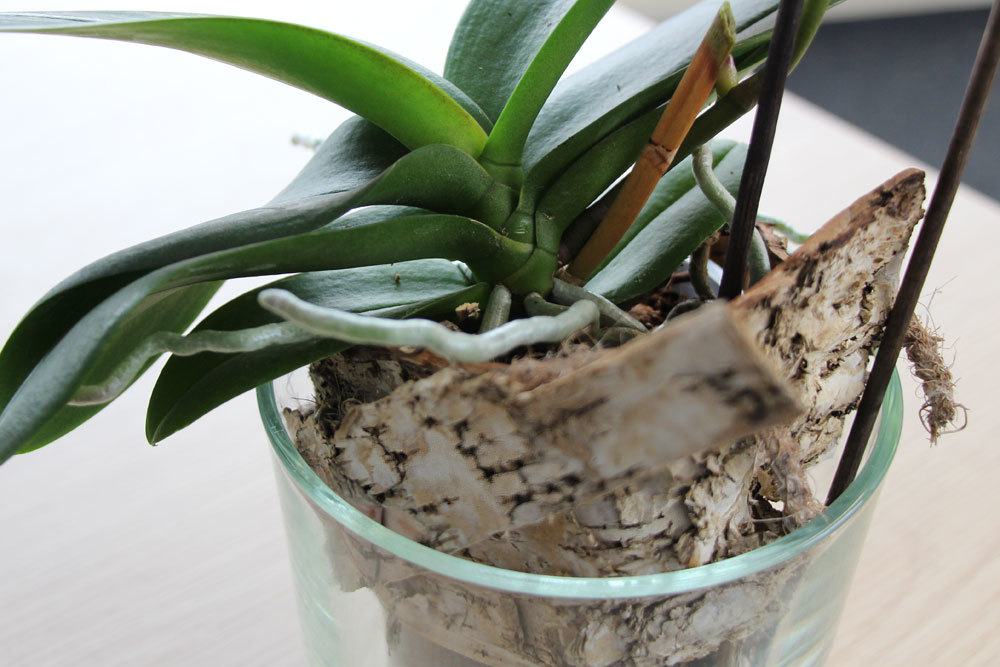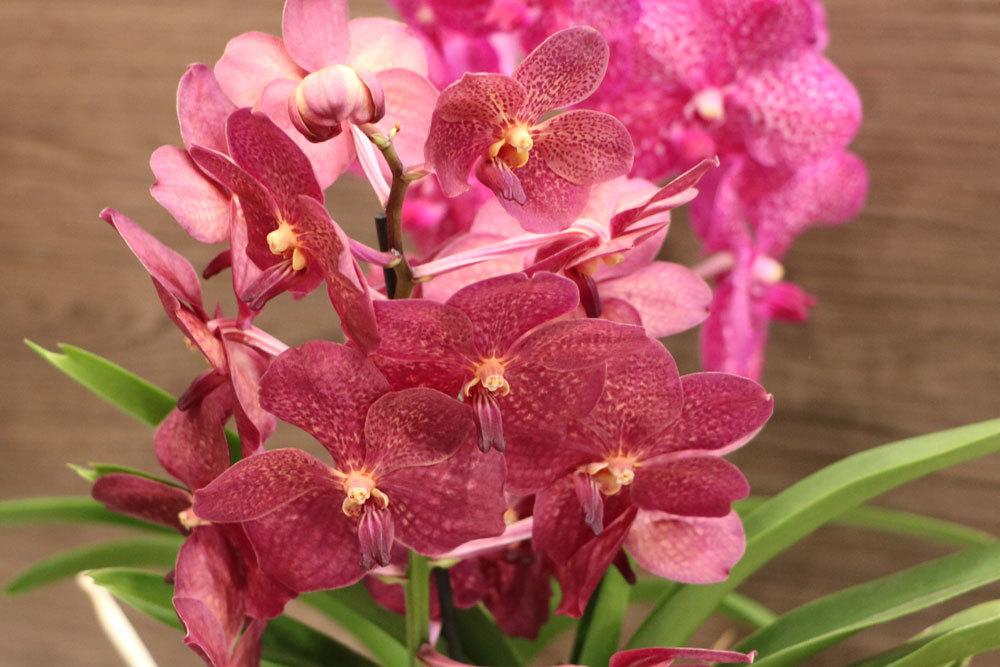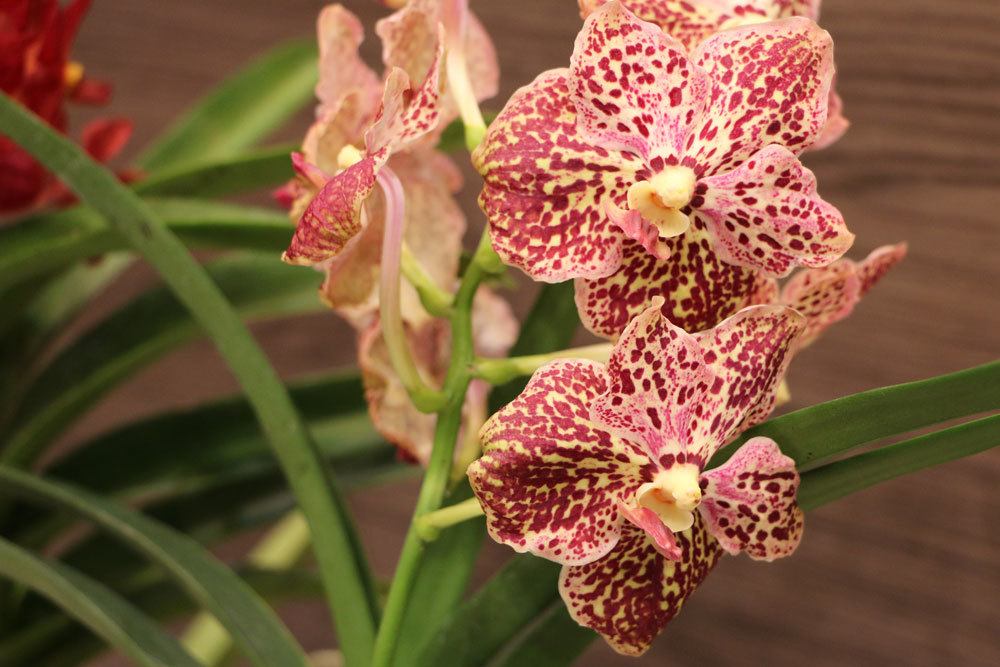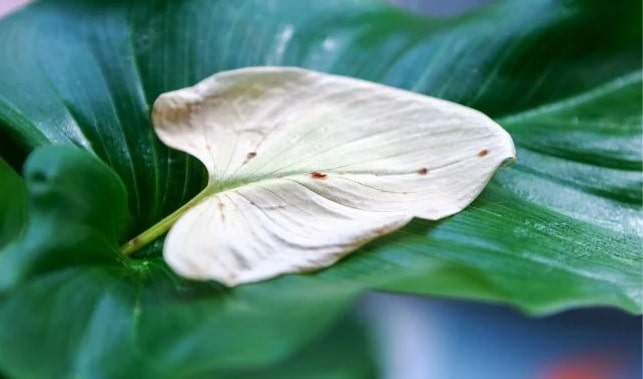Repotting the orchid makes a significant contribution to its healthy growth. Here it has a different requirement than many other plants. When is the right time, which substrate should be used and how to repot, describes the orchid guide in detail.
Contents
- 1 Repotting
- 2 Necessity
- 3 Substrate
- 4 Which substrate?
- 5 Substrate types
- 6 Expanded clay
- 7 Wood fibers
- 8 Garden soil
- 9 charcoal
- 10 lime
- 11 Compost
- 12 Coconut fibers
- 13 Cork/grist
- 14 Lavalite
- 15 Clay
- 16 Perlite
- 17 bark
- 18 Sand
- 19 Foam
- 20 Seramis
- 21 Sphagnum
- 22 Styrofoam balls
- 23 White peat
- 24 Styrofoam chips
- 25 Zeolite
- 26 Time
- 27 Preparation
- 28 Soil removal
- 29 Root treatment
- 30 Pot selection
- 31 Expanded clay drainage
- 32 Planting
- 33 Substrate filling
- 34 Watering
- 35 Fertilizing
- 36 Author
Repotting
Unlike most other plants, orchids do not tolerate repotting well, so they should be repotted much less frequently. A need due to lack of space does not arise as quickly, so again, there is no need for annual repotting. Nevertheless, a new substrate is needed from time to time. How to do this properly and when is the appropriate time, you will learn below.
Necessity
Reasons for repotting are manifold with many other plants, but usually root growth causes pots to become too small after one or two years and the roots can no longer spread. This is different with the orchid, because its roots intertwine, like to hold on to the edges of the pot and are also allowed to grow out of the bottoms of the pots or the substrate. Therefore, the orchidaceae copes well even with small pots, so that here is rarely a need to repot.
Substrate
However, the best substrate will rot one day. It becomes increasingly compacted and in this way constricts the roots. This prevents them from growing. In addition, the water permeability decreases, the roots become too entangled and the salt content in the substrate can increase due to the watering water, the older the substrate becomes. For the sensitive plant, this can lead to life-threatening damage.

It should be noted in principle that repotting is a burden for the orchid plants, initially weakens them, and therefore repotting should be done only every few years. Exceptions are situations where pests, diseases or moldy, algal substrate requires repotting because the roots of it could be exposed to health risks.
Which substrate?
There are countless substrates to choose from for orchids, which are precisely matched to their requirements. However, there are differences in quality, which is why you should always choose higher quality products. These are usually a bit more expensive, but in the long run your orchid will thank you for this investment with health and vigorous growth. In general, a good substrate should meet the following requirements.
- loose and water-permeable
- low in lime
- enriched with nutrients and minerals
- pH value between 5.5 and 6.0
- often provided with additives, which serve the water storage and/or soil permeability
Substrate types
Below you will find an overview of possible orchid substrates or ingredients, and what they do.
Expanded clay
- well suited – high water storage
- large water evaporation on the surface
Wood fibers
- suitable as an additive – stores water
- optimizes soil aeration

Garden soil
only suitable for some soil specimens, such as Bletilla
charcoal
- suitable as an additive – has a disinfecting effect in case of bacterial infestation
- binding of toxins
- has a loosening effect
lime
- especially important for the Paphiopedilum genus
Compost
- as an additive in solid consistency only suitable for terrestrial orchids – is very rich in nutrients
Coconut fibers
- suitable as an additive – protects especially young roots
- provides improved light conditions
Cork/grist
- usually included in epiphytic substrates to increase air permeability
Lavalite
- optimal for lithophytic growing orchids, like stone lilies, because it is water repellent
Clay
- highly recommended for pot orchids, because it retains water enormously
Perlite
- very suitable, especially for young plants – increases air permeability
- lets the substrate sit loosely
bark
- as an additive in mostly epiphytic standard substrates – the more tender the roots, the smaller the pieces should be

Sand
- less suitable, as it causes substrates to dry out more quickly
- suitable only in case of overwatering
Foam
- suitable as an additive especially for older orchids – increases air permeability
Seramis
- suitable as an additive for old and sole substrate for young plants
- high water storage with slow release

Sphagnum
- less suitable, as it decomposes quickly and usually requires annual repotting
Styrofoam balls
- conditionally suitable in substrate – water and nutrient repellent
- increases air permeability
- lowers pH-value
White peat
- not suitable – absorbs a lot of water
- but compacts quickly and reduces light permeability
Styrofoam chips
- well suited as drainage – has a water-repellent effect
Zeolite
- suitable for prevention of too much fertilizer application, as it stores it and slowly releases it again
Time
For the orchid, a time frame of between two and four years applies for regular repotting, so that it can develop optimally and remain healthy. The best time to repot is when the plant has new shoots, which should be about one third of their adult size before repotting. Most orchids sprout in the spring, so this is also the best time to repot.
Some orchid species form new shoots in the fall, so these can also be transplanted into fresh substrate here. However, the months from October to the end of January are less suitable. As a rule, during this period, the light conditions are significantly lower than those that prevail from February to September. Due to the lack of light, the plant loses energy and strength, which puts it under even greater stress when repotting.
Preparation
Before repotting, it is useful to make some preparations. Since repotting is energy-sapping for the orchidaceae and it should not be provided with additional nutrients immediately afterwards, fertilizing beforehand with a good watering is advisable. To do this, one or two days before repotting, immerse your plant in a water bath and add some orchid fertilizer. Watering also has the advantage that you can remove the plant from the culture pot more easily afterwards.
In addition, you should have some utensils ready before you start repotting:
- sharp cutting tool
- 70 or 80 percent alcohol to disinfect the cutting tool
- Slightly larger culture pot and special orchid repotting pot, if necessary.
- Spray bottle
- orchid substrate
- Expanded clay
- charcoal or sulfur powder for sealing the cuttings
- Transplant
- Potting out
The special trick here is not to damage the roots. If external aerial roots are too intertwined, they should be carefully pulled apart. Watering beforehand should make it easy to pull off the culture pot after you have pressed the side walls in a little all around. This will loosen roots from the pot wall and loosen the soil.
If the plant is not easy to remove, do not use excessive force, because the chance of damage to the roots will be too high. Simply cut the culture pot open with scissors, if possible, without cutting into roots.
Soil removal
Old substrate likes to stick to the roots and will stick the tighter the roots are intertwined. To completely loosen the old substrate from the plant, it is usually sufficient to tap out the root ball on a hard surface. Be careful not to damage the roots. Experience shows that tapping out works better if you proceed in stages.
That is, first tap out the lower root area while holding the remaining roots. Then release the middle root area from your hand, tap out again, and repeat until you reach the top root area. If substrate is completely bracketed by roots, leave it there, as a solution can do more damage than leaving the old soil in place.
TIP: You can also remove stubbornly attached soil by holding the roots under a stream of water for a few seconds, allowing the water pressure and moisture to loosen it. Use lukewarm water.
Root treatment
Now is the perfect time to inspect the roots for any pests or diseases such as rot. Even if you don’t discover any pests, it is recommended to place the orchidaceae in a lukewarm water bath for two to three hours. Doing so will suffocate most pest species that you may have missed.
In addition, you should follow these steps:
- cut off rotten or dead roots with sharp scissors or a knife
- never cut healthy roots, as growth could be extremely restricted
- if four or more bulbs are present, the oldest can be cut off for more vigorous new shoot growth
- always dust interfaces with sulfur or charcoal powder to minimize the risk of infection
- if possible, do not accidentally cut/injure healthy root tissue

Pot selection
In principle, it is advisable to choose a new culture pot that is no more than five centimeters larger than the previous one. Although many species of orchids do not necessarily need more space every few years and feel comfortable in confined environments, a larger pot favors the growth of new shoots in all species.
The pot should be plastic and transparent so that daylight can shine through, which the roots need. If you use the old pot again, disinfection must take place. Rinse it with alcohol or clean it thoroughly with a clean cloth previously dipped in alcohol and then let the pot air dry. Conventional beverage alcohol is not suitable for disinfecting.
Expanded clay drainage
Before the culture pot is filled with substrate or the plant is inserted, the bottom should be lined with expanded clay. A thickness of one centimeter is usually sufficient here. The expanded clay acts as a drainage system at the bottom of the pot and helps to prevent waterlogging.
Planting
Once the expanded clay drainage is in place, planting begins. To prevent the roots from becoming wedged or kinked, there is a trick: insert the orchid slightly rotating! The orientation must be such that new shoots get enough distance from the edge of the pot and can develop optimally.
Substrate filling
If the orchidaceae is sitting in the culture pot, the orchid substrate is added. This is done in portions, having previously moistened it well with a water-filled spray bottle. The replenishment is done as described in the following steps.
- before each new portion, lightly tap the pot with the bottom on a hard surface to settle the soil
- when the pot is three-quarters full, check/adjust the plant alignment again
- fill the substrate only so high that it slightly touches the new shoots at the most – otherwise there is a risk of rotting
- around the main stem the substrate for more plant hold, lightly press down
- trough that results, loosely fill with substrate.
Alternatively, expanded clay can be used. This is also moistened beforehand, and the pot is regularly tapped on a hard base, because expanded clay must also settle. For stabilization of the plant can additionally serve a plastic rod.
Watering
Water the orchid after repotting only after about five days. This has the purpose that possibly damaged roots recover and interfaces do not begin to rot due to the additional moisture. However, since it still needs moisture, it is sprayed daily with low-lime water after repotting. Orchid plants have absorbent leaves, so in this way there can be no drying out during the watering break.
Fertilizing
Both new, fresh substrate and expanded clay usually already contain nutrients and minerals. Additional fertilizing could cause an overdose, which will harm the orchids. For this reason, do not fertilize the plant for the first three to four weeks after repotting.





